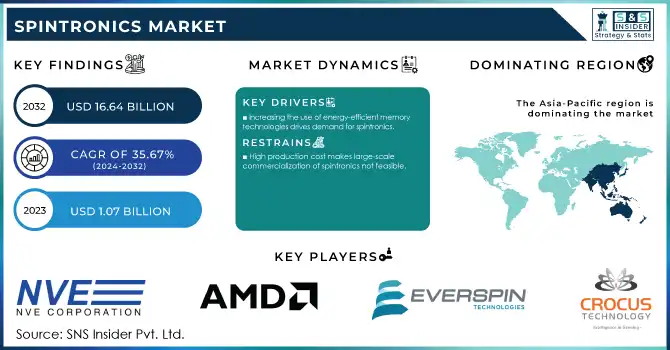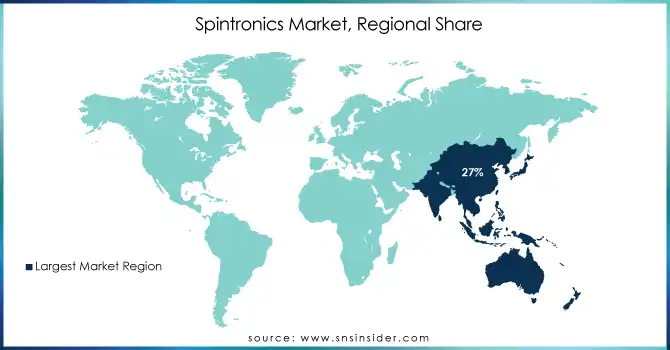Spintronics Market Size & Overview:

Get More Information on Spintronics Market - Request Sample Report
The Spintronics Market Size was valued at USD 1.07 Billion in 2023 and is expected to reach USD 16.64 Billion by 2032 and grow at a CAGR of 35.67% over the forecast period 2024-2032.
The Spintronics Market, blending quantum mechanics and electronics, is swiftly progressing worldwide. Spintronics, an abbreviation for spin transport electronics, utilizes the quantum characteristic of electron spin alongside charge, facilitating ground-breaking advancements in data storage, sensing, and processing. Main countries fuelling this expansion feature the U.S., Japan, China, Germany, France, and India, all of which are emphasizing semiconductor advancement. For example, the U.S. government has significantly invested in spintronics research as part of its quantum technology initiatives, and Japan has also established industry-academic collaborations to commercialize advanced spintronic devices. Likewise, China's Ministry of Science and Technology has also allocated a huge amount in 2023 to enhance spintronic development in its semiconductor industry.
Technological breakthroughs remain the epitome of the growth potential in this market. Advances in MRAM and extra-sensitive magnetic sensors are truly changing energy efficiency and high-performance benchmarks for industries such as aerospace and automotive systems. Leading firms in 2023 developed advanced German and French versions of their MRAM, which supports the emerging requirements for memory-intensive, power-efficient memory for AI-intensive applications, while India has been encouraged by such government initiatives in building cost-competitive and scalable technologies along these lines.
The recent launches, which include such things as the next generations of magnetic sensors for implementation in autonomous vehicles, advance precision in both navigation systems and safety mechanisms. Furthermore, spintronics outside of automotive continues to expand into healthcare and consumer electronics with compact efficient memory solution applications.
Future applications have the potential for exponential expansion in quantum computing, robotics, and edge computing-based applications. For instance, integrating MRAM in data centers is likely to save up to 30% in terms of energy consumption-a major goal of sustainability on the global level. Other initiatives are government policies within the Europe, Asia-Pacific and U.S. encouraging the R&D in the domain of spintronics. Technological innovation with strategic investments is thus creating a transformative trajectory for the market of spintronics. As a result, this becomes the pivot area of interest among various industries and governments globally.
Spintronics Market Dynamics
KEY DRIVERS:
-
Increasing the use of energy-efficient memory technologies drives demand for spintronics.
As energy efficiency is taken up as a global objective, solutions based on spintronics, such as MRAM, are gradually becoming popular. Traditional memory devices, such as DRAM and SRAM, consume considerable amounts of energy, especially in data centers. MRAM, based on principles of spintronics, ensures ultra-low power consumption along with greater durability. The U.S. Department of Energy emphasizes a 30% possible decrease in energy consumption for data centers through the use of MRAM.
Moreover, industry sources indicate that MRAM's writing endurance surpasses 10^12 cycles, greatly exceeding that of conventional flash memory. This change corresponds with global sustainability objectives, as nations such as Germany and Japan promote environmentally friendly technologies. The scalability and performance of MRAM render it essential for cloud computing, IoT devices, and edge computing, speeding up its integration into various sectors.
-
Increased safety and automation requirements drive spintronic sensor implementation in vehicles.
Advanced driver assistance systems and autonomous driving in the automotive sector are highly dependent on precise magnetic sensors, a fundamental application of spintronics. These sensors guarantee correct rotational and positional information to be detected, which are essential for safety features such as anti-lock braking systems and navigation. Industry reports claim that magnetic sensors have increased the efficiency by 25% as compared to Hall effect sensors.
The governments in China and India are supporting electric vehicles, offering them subsidies and tax incentives. These will indirectly enhance the components of spintronics. In Japan, car manufacturers are using spintronic sensors to enhance their performance and meet strict environmental regulations. With innovation the core focus of the automotive industry, spintronic sensors will surely transform vehicle systems.
RESTRAIN:
-
High production cost makes large-scale commercialization of spintronics not feasible.
Though it has many advantages, the market for spintronics faces major obstacles in the high cost of raw materials and complicated manufacturing process. Spintronic devices need fabrication technologies like molecular beam epitaxy, which is quite expensive and needs highly specialized equipment and human expertise. Industry sources have reported that the cost of manufacturing spintronic components is 40% higher than the semiconductor counterparts. Furthermore, even rare earth magnets, like the ones in spintronic sensors, have raw materials whose price fluctuation inflates cost.
There have been reports from countries, such as the U.S. and China, who have documented this hurdle as a constraint, hence their investment in R&D into making it easier for manufacturing. Until there are serious breakthroughs in more efficient and cheap production, spintronics technology cannot be adopted widely. This restraint requires collective efforts by academia, industries, and governments to develop scalable production techniques.
Spintronics Market Segmentation Analysis
BY PRODUCT TYPE
Sensors segment dominated in 2023 with a 38% market share as these are widely applied in automotive, healthcare, and industrial automation applications. Magnetic sensors, capitalizing on spintronic technology, are unmatched for sensitivity and reliability and represent a crucial element of ADAS, safety-critical systems.
Memory segment is projected to grow with the CAGR of 36.28% during the 2024-2032 forecast period due to transformative potential in data storage, for example, MRAM combines non-volatility with high-speed performance to meet emerging energy-efficient memory requirements in both data centers and consumer electronics. Recent technological advancements and government policies supporting semiconductor innovation have significantly accelerated the development and deployment of these product types. The increasing integration of spintronic products into emerging technologies positions this market segment for robust growth.
BY APPLICATION
The Magnetic Sensors segment led in 2023 with 32% market share, which reflects the critical role of magnetic sensors in enhancing automotive safety and industrial automation systems. Magnetic sensors are used to detect magnetic fields with high precision, making them indispensable in applications such as navigation and medical imaging.
The MRAM segment is expected to grow with the fastest CAGR of 36.73% during the forecast period of 2024-2032. This growth is due to the growing energy-efficient memory demand in data centers and IoT devices. Governments of regions like Europe and Asia-Pacific are actually funding R&D projects on spintronic applications. This would further expedite the growth of these technologies. The application of this technology in quantum computing and advanced robotics is also seen to open up newer prospects.
Spintronics Market Regional Overview
The region leading in 2023 with 27% share in the market is the Asia-Pacific region, stimulated by strong semiconductor manufacturing in nations like China, Japan, and South Korea. Various government initiatives, as demonstrated by China's "Made in China 2025" program, with domestic semiconductor innovation, boost spintronics R&D.
Europe is expected to be the fastest-growing market with a CAGR of 36.98% in the forecast period 2024-2032. This growth is supported by significant investments in quantum technology and sustainability-focused projects. Germany and France are leaders in this regard, where spintronics are used for energy-efficient solutions in industrial and automotive applications. Governments and private sectors worldwide are making collaborative efforts to create a dynamic and competitive landscape for the spintronics market.

Get Customized Report as per Your Business Requirement - Enquiry Now
KEY PLAYERS
Some of the major players in the Spintronics Market are
-
NVE Corporation (MRAM chips, GMR sensors)
-
Advanced Micro Devices (AMD) (MRAM solutions, magnetic memory)
-
Crocus Technology (magnetic sensors, TMR memory)
-
Everspin Technologies (MRAM products, spintronic memory)
-
Avalanche Technology (MRAM memory, aerospace solutions)
-
Intel Corporation (MRAM storage, spintronic sensors)
-
Samsung Electronics (STT-MRAM, memory modules)
-
IBM Corporation (quantum spintronic research, MRAM devices)
-
Hitachi Metals (magnetic materials, spintronic sensors)
-
Toshiba Corporation (MRAM storage, memory technologies)
-
Fujitsu Limited (magnetic sensors, spintronic R&D)
-
Micron Technology (spintronic memory, MRAM systems)
-
Seagate Technology (hard disk drives, spintronic sensors)
-
Western Digital Corporation (hard disks, MRAM memory)
-
Sony Corporation (spintronic sensors, advanced memory)
-
Applied Materials (spintronic manufacturing tools, MRAM systems)
-
GlobalFoundries (STT-MRAM, semiconductor solutions)
-
TSMC (Taiwan Semiconductor Manufacturing Company) (spintronic wafer production, MRAM chips)
-
Infineon Technologies (automotive sensors, spintronic components)
-
Qualcomm Technologies (low-power memory, spintronic R&D).
MAJOR SUPPLIERS (Components, Technologies)
-
AMG Advanced Metallurgical Group (specialty metals, rare earth materials)
-
Hitachi Metals (magnetic materials, ferrite cores)
-
Shin-Etsu Chemical (semiconductor-grade silicon, magnetic materials)
-
TDK Corporation (magnetic components, ferrite cores)
-
Materion Corporation (beryllium alloys, rare earth magnets)
-
Sumitomo Metal Mining Co. (rare earth elements, cobalt materials)
-
Nichia Corporation (magnetic materials, phosphors)
-
Daido Steel Co. (alloy materials, specialty steel)
-
Showa Denko K.K. (hard disk substrates, magnetic materials)
-
Heraeus Group (precious metals, conductive materials).
MAJOR CLIENTS
-
Tesla Inc.
-
Apple Inc.
-
Google LLC
-
Amazon Web Services (AWS)
-
General Electric
-
Toyota Motor Corporation
-
Intel Corporation
-
Samsung Electronics
-
IBM Corporation
-
Siemens AG
RECENT TRENDS
-
June 2024: USD 400,000 award went to NVE Corp., of Eden Prairie from Minnesota Department of Employment and Economic Development, commonly referred to as DEED. Awards provide financing through the Minnesota Investment Fund (MIF), which helps in the addition of new workers and the retaining of high-quality jobs toward industrial, manufacturing and technology-based industries.
-
August 2023: Allegro MicroSystems announced that it has entered into a definitive agreement to acquire Crocus Technology, a developer of magnetic sensors based on tunnel-magnetoresistance (TMR) technology. The transaction is valued at USD 420 million and will be paid in cash.
| Report Attributes | Details |
|---|---|
| Market Size in 2023 | USD 1.07 Billion |
| Market Size by 2032 | USD 16.64 Billion |
| CAGR | CAGR of 35.67 % From 2024 to 2032 |
| Base Year | 2023 |
| Forecast Period | 2024-2032 |
| Historical Data | 2020-2022 |
| Report Scope & Coverage | Market Size, Segments Analysis, Competitive Landscape, Regional Analysis, DROC & SWOT Analysis, Forecast Outlook |
| Key Segments | • By Device Type (Semiconductor Based Spintronics, Metallic Based Spintronics, Alloy Based Spintronics), • By Product Type (Sensors, Memory, Others) • By Application (Magnetic Sensors, Spintronic Couplers, MRAM, Hard Disks, Microwave Devices) |
| Regional Analysis/Coverage | North America (US, Canada, Mexico), Europe (Eastern Europe [Poland, Romania, Hungary, Turkey, Rest of Eastern Europe] Western Europe] Germany, France, UK, Italy, Spain, Netherlands, Switzerland, Austria, Rest of Western Europe]), Asia Pacific (China, India, Japan, South Korea, Vietnam, Singapore, Australia, Rest of Asia Pacific), Middle East & Africa (Middle East [UAE, Egypt, Saudi Arabia, Qatar, Rest of Middle East], Africa [Nigeria, South Africa, Rest of Africa], Latin America (Brazil, Argentina, Colombia, Rest of Latin America) |
| Company Profiles | NVE Corporation, Advanced Micro Devices, Crocus Technology, Everspin Technologies, Avalanche Technology, Intel Corporation, Samsung Electronics, IBM Corporation, Hitachi Metals, Toshiba Corporation, Fujitsu Limited, Micron Technology, Seagate Technology, Western Digital Corporation, Sony Corporation, Applied Materials, GlobalFoundries, TSMC, Infineon Technologies, Qualcomm Technologies. |
| Key Drivers | • Increasing the use of energy-efficient memory technologies drives demand for spintronics. • Increased safety and automation requirements drive spintronic sensor implementation in vehicles. |
| Restraints | • High production cost makes large-scale commercialization of spintronics not feasible. |

